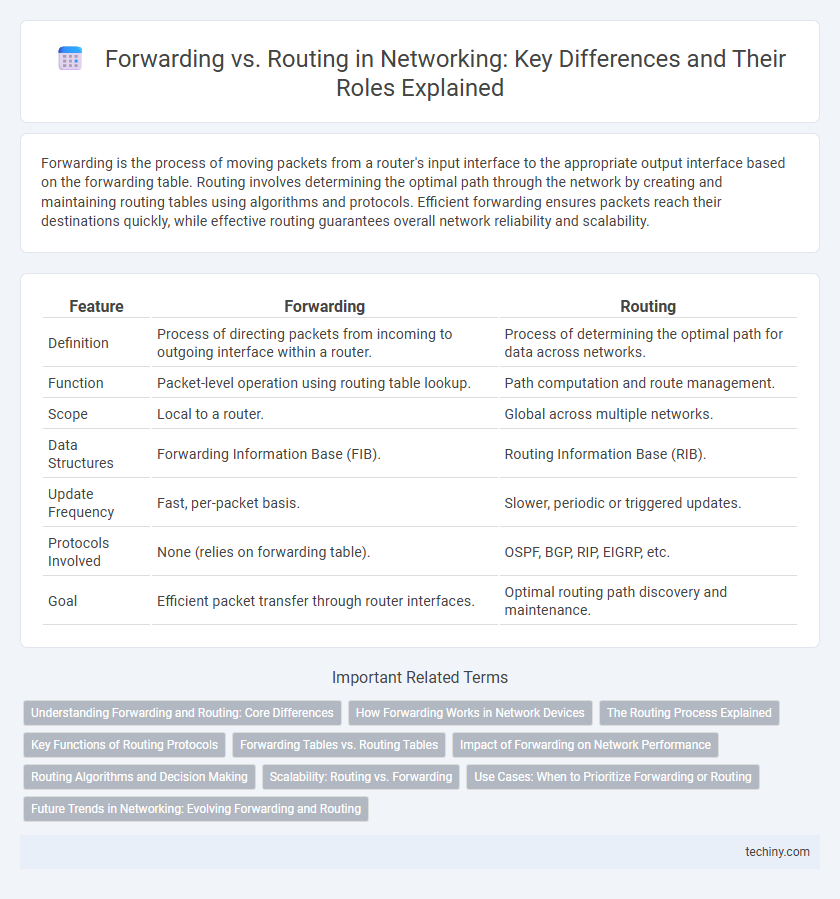Forwarding is the process of moving packets from a router's input interface to the appropriate output interface based on the forwarding table. Routing involves determining the optimal path through the network by creating and maintaining routing tables using algorithms and protocols. Efficient forwarding ensures packets reach their destinations quickly, while effective routing guarantees overall network reliability and scalability.
Table of Comparison
| Feature | Forwarding | Routing |
|---|---|---|
| Definition | Process of directing packets from incoming to outgoing interface within a router. | Process of determining the optimal path for data across networks. |
| Function | Packet-level operation using routing table lookup. | Path computation and route management. |
| Scope | Local to a router. | Global across multiple networks. |
| Data Structures | Forwarding Information Base (FIB). | Routing Information Base (RIB). |
| Update Frequency | Fast, per-packet basis. | Slower, periodic or triggered updates. |
| Protocols Involved | None (relies on forwarding table). | OSPF, BGP, RIP, EIGRP, etc. |
| Goal | Efficient packet transfer through router interfaces. | Optimal routing path discovery and maintenance. |
Understanding Forwarding and Routing: Core Differences
Forwarding involves the process of moving a packet from an incoming interface to the appropriate outgoing interface within a single router, using the information in the forwarding table. Routing refers to the overall determination of the optimal path for data to travel across multiple networks, managed by routing protocols such as OSPF, BGP, and RIP. While forwarding operates at the data plane for packet handling, routing functions at the control plane to build and update routing tables.
How Forwarding Works in Network Devices
Forwarding in network devices involves the direct process of moving packets from an incoming interface to an outgoing interface based on the destination address found in the packet header. Network devices like routers and switches use forwarding tables or routing tables that contain precomputed paths to determine the best next hop for each packet efficiently. This mechanism enables rapid packet delivery by avoiding complex route calculations during the forwarding process, ensuring minimal latency and optimized traffic flow within the network.
The Routing Process Explained
The routing process involves determining the best path for data packets to travel across complex networks using routing algorithms and protocols such as OSPF, BGP, and EIGRP. Routers maintain routing tables that store network topology information, enabling dynamic decision-making for packet forwarding based on destination IP addresses. This process contrasts with forwarding, which simply directs packets along the predetermined route without recalculating paths.
Key Functions of Routing Protocols
Routing protocols determine optimal network paths by dynamically exchanging topology information and maintaining routing tables to ensure efficient packet delivery. They use algorithms such as Distance Vector, Link State, or Path Vector to calculate the best routes based on metrics like hop count, bandwidth, delay, and cost. These protocols enable network scalability, fault tolerance, and adaptive route selection in complex network environments.
Forwarding Tables vs. Routing Tables
Forwarding tables store precomputed paths used by switches and routers to quickly direct data packets at the hardware level, ensuring efficient packet delivery within a local network segment. Routing tables contain network topology information and routing policies that routers use to determine the best path for forwarding packets across different networks, updated through routing protocols like OSPF, BGP, or RIP. Unlike routing tables that influence path selection, forwarding tables focus on high-speed packet processing with minimal delay by mapping destination addresses to specific outgoing interfaces.
Impact of Forwarding on Network Performance
Forwarding directly impacts network performance by determining how efficiently packets are moved from the input to the output interface within a device, minimizing latency and maximizing throughput. High-speed forwarding mechanisms like hardware-based switching and ASICs enable rapid packet processing, reducing bottlenecks and improving overall network responsiveness. Efficient forwarding reduces CPU load on routers, allowing routing algorithms to focus on optimal path calculation rather than packet movement, enhancing scalability and network stability.
Routing Algorithms and Decision Making
Routing algorithms determine the optimal path for data packets by analyzing network topology, bandwidth, delay, and congestion metrics to enhance efficiency and minimize latency. Decision making in routing involves protocol-specific mechanisms such as distance-vector, link-state, and path-vector algorithms, each optimizing route selection based on criteria like hop count, link cost, and network state information. Dynamic routing protocols such as OSPF, EIGRP, and BGP implement these algorithms to adapt routes in real-time, ensuring reliable and scalable data transmission across complex networks.
Scalability: Routing vs. Forwarding
Routing scales effectively by distributing network paths and updating routing tables dynamically across routers, enabling efficient management of large and complex networks. Forwarding operates at a hardware level using fixed, pre-established routes optimized for speed, but lacks the adaptability needed for scaling in evolving network topologies. Routing protocols such as OSPF, BGP, and EIGRP enhance scalability by allowing routers to learn and adjust routes, whereas forwarding remains a streamlined process focused on packet transmission based on existing routing decisions.
Use Cases: When to Prioritize Forwarding or Routing
Forwarding is prioritized in high-speed data transfer within a local network, enabling efficient packet delivery based on MAC addresses in LAN environments or MPLS switching. Routing is essential when determining optimal paths across diverse networks or the internet, using IP addresses and dynamic protocols like OSPF or BGP to manage complex traffic flows and ensure network scalability. Use cases favor forwarding for intra-network speed optimization and routing for inter-network path selection and traffic management.
Future Trends in Networking: Evolving Forwarding and Routing
Future trends in networking emphasize the integration of AI-driven algorithms to enhance forwarding efficiency and dynamic routing decisions. Advances in programmable data planes and Software-Defined Networking (SDN) enable real-time network adaptability, improving scalability and reducing latency. Emerging technologies like segment routing and intent-based networking further evolve traditional forwarding and routing paradigms for automated, intelligent traffic management.
Forwarding vs Routing Infographic

 techiny.com
techiny.com